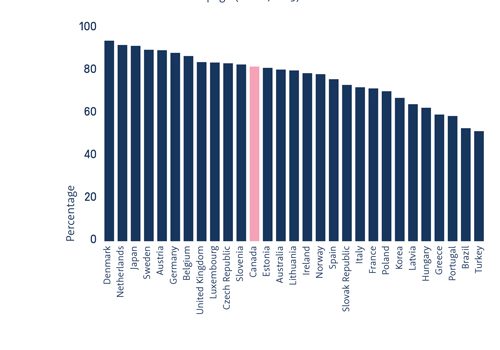 By Alejo Lopez
By Alejo Lopez
These new times are challenging our worldwide communications programs and are still shaping the way brands and consumers interact with one another. Even so, email is still the channel with the most ROI among all the different digital marketing channels, contributing as much as forty-two times return on investment (ROI) for every dollar spent wisely. The key is wisely.
With the eCommerce boom and digital content consumption increased, email marketing is not going away as a key channel any time soon. In fact, email became, again, in front of any digital strategy and continues to bring meaningful results and therefore revenue to businesses. If you aren’t using email or you are getting poor results over your email campaigns, it’s time to rethink your digital marketing strategy, start using email and squeeze all the juice of this channel.
Let’s take a look at the way we want to go about building a plan that might bring you those kinds of huge returns. These are the elements of a Top 10 Checklist when you go about designing an email strategy and rollout. Some may seem basic or obvious, but you’d be surprised how often they can be overlooked or taken for granted.
1. Define your campaigns strategy based on your business objectives and the impact that you want to reach.
2. Build your own database, know each customer thoroughly and create different segments based on personal interests
3. Use a memorable sender name and configured it with the recommended security protocols.
4. Find the perfect day, time and frequency to send your messages.
5. Don’t ignore or forget about the curiosity gap. Use a creative & Impactful subject lines.
6. Have clear and specific objective of what you need to achieve with your message. To inform? Bring traffic to your digital assets? Get clicks and/or conversions? Build each campaign focusing on those objectives.
7. You absolutely, without exception, A/B test all you campaigns.
8. Take much care about your reputation. Measure and protect your sender scoring.
9. Personalize your emails in a way you’d expect to be treated yourself.
10. Successful email marketing can be made simple. So automate it.
We highly recommend you base your email campaigns and automation marketing messages on your business goals and the impact that you want to achieve as the most crucial driver.
Using a methodology such as SPICED METHODOLOGY your emails strategy will take a different approach:
SITUATION: Describe the moment your business is living right now, the pain points and challenges, and the impact you want to deliver to your customers with your services and your communications
• PAIN: Which are the Issues and the Dissatisfaction that are making not possible you give that impact to your customers
• IMPACT: Which is the Quantitative impact that you will get if your campaigns succeed. INCREASE REVENUE, DECREASE COSTS, IMPROVES CUSTOMERS EXPERIENCE, ETC
• CRITICAL EVENT: Which are the critical moments/events, deadlines that you have to address in the following months, what happens if you miss them, how can you email and multichannel communications will help to address them
• DECISION PROCESS: What do you have to do? Who else has to be involved in the process to go ahead with it
SITUATION: Describe the moment your business is living right now, the pain points and challenges, and the impact you want to deliver to your customers with your services and your communications
• PAIN: Which are the issues and the dissatisfaction that are making not possible you give that impact to your customers
• IMPACT: Which is the Quantitative impact that you will get if your campaigns succeed. INCREASE REVENUE, DECREASE COSTS, IMPROVES CUSTOMERS EXPERIENCE, ETC
• CRITICAL EVENT: Which are the vital moments/events, deadlines that you have to address in the next months, what happens if you miss them, how can you email and multichannel communications will help to address them.
• DECISION PROCESS: What do you have to do? Who else has to be involved in the process to go ahead with it?
Define your campaign strategy based on your business objectives and the impact that you want to reach. Different customers have different needs. Some services allow you to purchase databases, but we highly recommend not to do it and build your own database. Relate in a natural way with your customers that are minded to connect with you. It has a higher effort, but it paid off
Use all your different touch points to collect data about your users and customers, like websites, social media, call centers, or even physical stores. It starts with asking for basic information and then starts to know them thoroughly based on the engagement and interaction with your communications.
Build your own database, know each customer thoroughly and create a different segments based on personal interests. As you know, always the first impressions matter; in email marketing, If your email doesn’t stand out and build trust, your subscribers probably won’t bother opening it. Paying attention to your sender name is an essential best practice. Look for an email name that should be recognizable and memorable. Use some of this option and be creative and impactful
• Use your Brand Name and add some hint: Keith from emBlue
• Name + @ Keith @ emBlue
• [Brand Name] + Area : emBlue Customer Support, or emBlue Newsletter
• An attractive name for the communication: emBlue Digest, or emBlue Pulse
And finally avoid using NOREPLY@YOURCOMPANY. It’s like you are communicating that “We don’t care enough about you to check this inbox.”
Part 2: SPF, DKIM, and DMARC
The other main important part of the sender is the “Security Policies” configurations that are going to give you a higher level of security and to increase the possibilities to reach the inbox. The three main email security protocols are SPF, DKIM, and DMARC and complement one another, so implementing them all provides the best protection.
SPF (Sender Policy Framework) is a type of DNS that identifies the email servers that are permitted to send emails using a particular domain name, in this case, yours. It helps the recipient email server identify emails sent using your domain and separate and prevent those spammers that want to use it on your behalf. It is the first level of defence against spoofing.
DKIM (Domain Key Identified Record) is an authentication method, which uses email encryption with public/ private keys. It validates whether the emails are generated from the authorized servers. It is a further guarantee to a user’s email server that the email is legitimate. Think of DKIM as a hidden «digital signature» on your email.
DMARC (Domain-based Message Authentication, Reporting & Conformance) is an additional security level. It complements the SPF and DKIM, and It also adds a reporting function that allows senders and receivers to improve and monitor the protection of the domain from fraudulent email.
Are you using a memorable sender name, and have you configured it with the recommended security protocols? There are a lot of messages competing for reaching the inbox, and users’ attention gets our emails to be at the top of the inbox as most subscribers will pick the emails they see first, will increase the possibilities to be viewed. Identifying the best time and frequency regarding your different segments is a key part of achieving those objectives.
One study conducted by Return Path focused on the consequences of both under-mailing and over-mailing. In short, under-mailing leads to missed revenue opportunities, lower lifetime value, lack of inbox presence, poor or inconsistent sender reputation, inability to maintain a clean list and avoid spam traps, and — counter-intuitively — increased complaint rates. The study showed that the primary email recipients (those who accounted for 83 percent of all email reads), were able to tolerate up to about five emails per week from a given sender before their complaint rates increased dramatically., We recommend that at least have one weekly contact with your customers, based on adding value in each interaction.
Have you identified the perfect day, time and frequency to send your messages? Email based on the subject line. So it’s along with your Sender Name the first impression for an email. Your recipients will generally only see three things before they decide to open or ignore your message:
• Sender name
• Subject line
• Preheader
Provide enough information that hooks your audience and makes them curious. But don’t provide all the information until they click to open the email. Use some of the now more common methods used by social media with those enticed titles.
And try personalization in your subject and emojis. Both have shown to have a positive effect on average open rates.
Don’t forget about the curiosity gap
Use a creative & Impactful subject line. Don’t try to achieve all your objectives in the same message, focus each message to one or maximum two objectives. It can be inform about events or promotions, create awareness or Call to action to a schedule a meeting. Be direct and clear with the information and combine an attractive design between images and text included.
Remember that an image is worth a thousand words
Your emails need to be build incorporating stunning eye-pleasing visuals that help reinforce your text copy, creating an emotional connection and driving the expected results. Animated GIFs are also great options to consider, use them if they add value and reinforce your message.
Another important hints are to include ALT description text in your images. It not only helps people with visual impairments but also helps if your HTML does not render. Also, the ALT text make your ESP feel more comfortable with your emails and increases the chance to reach the inbox
All you efforts should not be left to chance. Using A/B testing ensures you choose the messages with the best options to get the results that you are perusing. With A/B testing you can test and see the most important factors of your campaign, Subject, Sender, and even the message is better to use data, not your gut feeling.
Running an A/B test is a relatively easy process and it helps you improve every part of your email campaign. It allows you to send randomly a different variation of the same campaign to two or more different samples of recipients.
Are you A/B testing all you campaigns?
Although more than 91 percent of the users read their emails daily, more than 76 percent say that one of the main reasons to unsubscribe from their email list is receiving too many emails for a brand with irrelevant content. As we said before, our recommendation is to send at least ten emails monthly, that is, more than two emails every week, depending on the business and the level of engagement of the users. We stress the importance of building a strong sending reputation. Your sending reputation gives you how mailbox providers (ESPs like Gmail, Hotmail, etc., and corporate emails) judge your mails, and it is driven by how your subscribers react and engage with your messages.
If your users are engaged with your messages, your sending reputation will increase, and your messages will be more likely to reach the inbox. On the other hand, if you have a lot of spam complaints, unsubscriptions, and unread, you will be more willing to go to the spam folder.
There is no single recipe or score to reach an excellent sender score across all mailbox providers, but there are some tools and tips you can use better understand your sending reputation.
1. Understanding your statistics trend: It is critical to understanding how your overall reputation is changing, your opens, clicks, bounce, complaints. We at emBlue have created Sender Scoring, which gives you a general idea of your campaigns engagement and let you know if you have an optimum behaviour overall your campaigns.
2. Check your Dedicate IP or IP Pool: Identify the best set-up option for you. It can be a dedicated IP or a Shared IP Pool; it depends on the volume of your daily emails and the ability to increase your sender score reputation.
3. Increase interactions: Build different kinds of campaigns based on your user’s engagement and treat Power Users (those with a high engagement) different than your cold users or never-open users.
4. Test your HTML Deliverability: Use the best practices when you design your emails, combine text and images in your email, use the correct HTML encoding. Take considerable care of your reputation. Measure and protect your Sender
A study conducted by Econsultancy found that 74 percent of marketers say targeted personalization increases customer engagement rates and increasing 6x transaction rate. Although subject personalization gets a 26 percent more likely to be opened, we invite you to think ahead of the subject and also personalize the email content based on user interests.
You can automatically personalize your emails, with the last item viewed by your users in the last email campaigns and on your website. You have different options to personalize your email, such as the Last Item Viewed, Last Category, Cart Abandonment, or any other “event” on your website that you want to use to personalize your messages.
Personalizing is worth all the effort that you put on:
• Giver customers a new and personal experience. Understanding your subscribers is all brand’s marketing goals makes your emails an enjoyable and exciting task, providing positive emotions.
• Improves engagement. Humanizing your communication will give much more appreciation because each subscriber will feel that your brand responds to their needs. Personalization increases shared value, and both sides win. Make your emails more impactful and relevant. People are being bombarded by tons of emails every day. When you personalize emails, you are squeezing all the potential of this channel.
How do you expect to be treated?
One of the hottest trends these days is marketing automation, and now more than ever when every business is looking for optimize time and expenses. When you automate your communications not only optimize your expense, but are giving a better customer experience. As the name suggested, automated communications is sending out messages to your customers automatically, based on different events or triggers as schedule or by action made by customers in your different digital assets. You can automate one-time event email or a complete drip campaign according to each customer journey.
Automated messages according to date and time
The exact moment in which the communication should be sent is predetermined by a specific date and time. Some Examples of automated scheduled messages are:
• Unique sending with established date.
• Messages on special and recurring dates such as birthdays, anniversaries, and events, such as Mother’s Day.
• Monthly recurrent messages such as credit card statements or insurance policies, also they can have an attached document if necessary
Automated messages based on a specific event or customer journey. Messages triggered automatically according to certain events that the user can perform on any digital asset like a website, a pop-up banner, or even in another email.
These actions activate different customers Journeys executing different messages like email, push notifications or SMS.
Examples of automated messages by triggers or events:
• Remarketing: According to the previous purchases of a user, you can automate the sending of an email after the purchase offering discount in other product.
• Abandoned Cart: Messages reminding and encouraging users to finalize their purchase on an abandoned cart is a great boost.
• By customer interest: Knowing user’s interests you can plan an automatic communication with relevant content according to those interests. These submissions can be triggered with user and password information when registering on your site.
It’s not enough just to know these Top Ten Checklist best practices and the types of emails you can send, or even brainstorm ideas about possible campaigns. It’s really important to be clear about your business strategy and how email and automation marketing can be integrated with the other marketing actions to get the best results for your business.
Have in mind always your customers to give them a unique experience to bond your audience, and build up a real message focused on your customers engaging them thoroughly with your brand.
Following these 10 steps, we assure you that you will approach to:
• Save time sending campaigns.
• Segmenting and have a granular approach to your customers
• Be more relevant through messages personalization
• High access to metrics
• Increase your ROI
How you choose to communicate with your clients can be the difference between increased conversion and the spam folder.
Alejo Lopez is Country Manager of emBlue, an email marketing automation platform.




